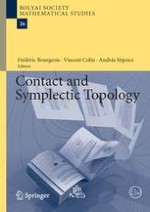2014 | OriginalPaper | Buchkapitel
A Topological Introduction to Knot Contact Homology
verfasst von : Lenhard Ng
Erschienen in: Contact and Symplectic Topology
Aktivieren Sie unsere intelligente Suche, um passende Fachinhalte oder Patente zu finden.
Wählen Sie Textabschnitte aus um mit Künstlicher Intelligenz passenden Patente zu finden. powered by
Markieren Sie Textabschnitte, um KI-gestützt weitere passende Inhalte zu finden. powered by
